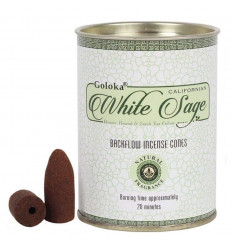All about white sage, the plant of well-being par excellence
Have you ever heard of white sage,this plant used for millennia in many cultures around the world?
Known for its medicinal virtues but also for its multiple uses during sacred rituals, white sage, also called California sage,contains a thousand and one secrets that Coco Papaya makes you discover in this article.
The history of white sage: bees, digestion and sacred plant
If there is one plant that has a name that fits perfectly for its use, it is sage!
Indeed, its Latin name, salvia, means to save, which makes it the plant that saves.
The famous white sage has the scientific name salvia apiana,from the Latin apis which means bee, because its leaves attract our favorite pollinating insects.
A sacred plant still frequently used in herbalism, white sage has crossed history, peoples and continents, both as a medicinal herb and as a food condiment.
If the Greeks and Romans used it to promote digestion, in China it soothed fever and cleared the respiratory tract while in Egypt it was served in herbal tea or infusion to prevent infertility.

White sage: the virtues of this ancestral medicinal plant
Among the some nine hundred species of sage in the world,white sage is today one of the most sought after and used, and for good reason... Rich in essential oil, it is the most aromatic variety, and it is for this reason that it is recognized for its therapeutic virtues.
White sage contains terpenes, molecules with pleasant fragrances and antiseptic and antibacterial properties. This is why we find this plant in the composition of many medical treatments aimed at the nervous system, the digestive system or the ENT sphere.
But that's not all: it also contains natural plant hormones,which explains its use in gynecology, to soothe painful periods for example.
Finally, there iseucalyptol, a very effective component for clearing the bronchi and soothing sore throats and colds.
We therefore note here that the medicinal virtues of sage are based on recognized pharmacological compounds.
The traditional purification rite: how to burn white sage can soothe your mind?
Inspired by indigenous rituals(fumigation or smudging),purification by white sage smoke is spreading more and more today, at a time when spirituality and modern witchcraft rites are on the rise.
Traditionally used to purify the rooms of the sick, white sage smoke cleans the spaces thanks to its antiseptic properties, but is also energy and emotionally effective.
According to the traditional Amerindian ritual, it is an act that allows to find a balance between body and mind, by driving out bad waves and unwanted emotions.
Here's how to practice this rite at home:
The white sage leaves are dried and then collected in a bouquet or fumigation stick (also called smudge) that you can get at Coco Papaya.
Like an incense stick, burn the end of your sage bouquet with a match or lighter. Let a few seconds pass before extinguishing the flame. A smoke will then emerge and diffuse its pleasant scent. Feel free to take your fumigation bouquet with your fingertips and walk through your living space clockwise to purify it.
You can perform the same ritual to purify a person or place.
Always give priority to safety when performing a purification rite with white sage: if you are indoors, ventilate the room properly and keep any flammable object or material at a safe distance from the fumigation stick. Be equally careful not to burn your fingers!

A sacred plant throughout history, white sage has been able to make a place for itself in our pharmacy kits thanks to its medicinal properties. She also invited herself into our interiors through ambient fragrances inspired by her recognizable fragrance among a thousand. Finally, the mysticism it arouses and the millennial spiritual heritage that it conveys have made it a very fashionable "well-being" ally currently!
And you, what do you think of white sage?
Have you ever used them?
Are you more sensitive to its medicinal or spiritual virtues?
Feel free to share your impressions in comments!
Sources:





















.JPG)



























Comments (0)